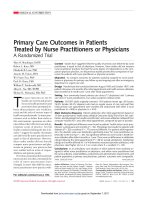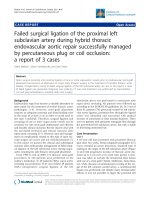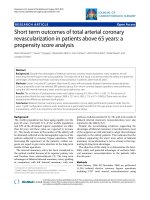Báo cáo y học: " Improving surgical outcomes: it is the destination not the journey" ppt
Bạn đang xem bản rút gọn của tài liệu. Xem và tải ngay bản đầy đủ của tài liệu tại đây (115.56 KB, 2 trang )
In the previous issue of Critical Care, Benes and
colleagues have demonstrated improvements in out-
comes for patients undergoing major intra-abdominal
gastrointestinal or vascular surgery by giving additional
fl uid boluses in order to maintain a variation in stroke
volume (SVV) <10%, rather than targeting the stroke
volume itself [1].
Targeting elevated oxygen delivery or stroke volume
improves outcome after high-risk surgery [2,3]. Protocols
used in these studies have required either pulmonary
artery catheterisation or the insertion of an oesophageal
Doppler monitoring (ODM) probe. e pulmonary artery
catheter is highly invasive, whilst the use of ODM is
restricted to the anaesthetised or heavily sedated patient.
Despite these limitations, ODM is considered a minimum
standard of care for high-risk surgical patients [4].
In many respects, Benes group’s fi ndings echo those of
ODM optimisation studies, in as much as the inter-
vention group received 400 ml more colloid than the
control group, and the length of stay and complications
were both reduced. What is diff erent, however, is the
monitoring parameter used as the targeted endpoint.
SVV is measured by pulse contour analysis (PCA), and is
one of a group of parameters that estimate preload
responsiveness – the other parameters being pulse
pressure variation and systolic pressure variation. Benes
and colleagues’ study is now the third study showing that
targeting preload responsiveness leads to improved
outcomes after major surgery [5,6].
We are all familiar with SVV whether we realise it or
not. e swing on an arterial line trace in the operating
theatre or in the intensive care unit alerts us to the
possibility that a patient is hypovolaemic and may
respond to a fl uid bolus. SVV eff ectively automates this
subjective observation. e eff ect of the increased intra-
thoracic pressure of mechanical ventilation is to decrease
venous return to the right side of the heart, reducing
right ventricular fi lling and output, leading to a reduced
left ventricular stroke volume. is continuous challenge
provided by mechanical ventilation allows estimation of
the adequacy of preload, by monitoring changes in the
stroke volume over a respiratory cycle, and the degree of
variation seen in either the stroke volume or the pulse
pressure indicates whether the subject would be respon-
sive to fl uid bolus by improving their stroke volume [7-9].
e benefi ts of a PCA system such as the Vigileo™,
LiDCORapid™ or PiCCO™ lie with the ease of use –
particularly in higher-risk patients, in whom invasive
arterial monitoring is routine. In contrast to the ODM, a
PCA technique can be used comfortably in awake
patients allowing stroke volume optimisation in the post-
operative environment, which has also shown to be of
benefi t [10]. ese PCA systems are little aff ected by
surgical movement or diathermy, and provide a simple,
consistent, and defi ned end point as to whether fl uid is
required based on SVV being >10% or <10%.
Preload responsiveness parameters are not without
their limitations: they require constant tidal volumes of
around 7 to 8 ml/kg and sinus rhythm; they are subject to
problems with damping of the arterial trace; and up until
now they had limited validation in terms of improved
clinical outcome.
With the use of SVV in goal-directed therapy, Benes
and colleagues have shown a signifi cant reduction in
Abstract
Studies have demonstrated that optimising the
circulating volume reduces morbidity after major
surgery. This optimisation is usually achieved through
maximisation of the stroke volume guided by
oesophageal Doppler. New monitoring parameters
of preload responsiveness using information from
the arterial trace are now showing some promise in
achieving the same goal. The present commentary
examines these new parameters with respect to
improving outcomes for the high-risk surgical patient.
© 2010 BioMed Central Ltd
Improving surgical outcomes: it is the destination
not the journey
Jonathan Wilson* and Simon Davies
See related research by Benes et al., />COMMENTARY
*Correspondence:
Department of Anaesthesia, York Teaching Hospital, Wigginton Road, York
YO318HE, UK
Wilson and Davies Critical Care 2010, 14:177
/>© 2010 BioMed Central Ltd
postoperative morbidity [1], which in the control group
was similar to other studies investigating high-risk
patients. A relatively homogeneous study group has been
investi gated; and although single centre, the methodology
is robust. is study has once again demonstrated that
so-called standard haemodynamic parameters are not
suitable targets to direct fl uid therapy. It would be
interest ing to know the timing of fl uid administration, as
this has also been suggested as a factor in the improved
outcomes [11]. Patients with dysrythmias, excluded from
the benefi ts of preload responsiveness, are likely to be a
true high-risk group, and it would be interesting to know
whether stroke volume optimisation using PCA could be
a useful alternative in this group. Studies are also
required to determine optimal values of SVV or systolic
pressure variation for predicting fl uid responsiveness as
determined by a signifi cant rise in stroke volume
measured by ODM, the current standard.
In summary, getting the preload right remains the
cornerstone of goal-directed fl uid therapy, and many of
us believe it should be a minimum standard of care for
the high-risk surgical patient. e range of tools to do the
job is expanding to suit all tastes – so although the
destination remains the same, it now seems the journey
can be made on diff erent paths.
Abbreviations
ODM, oesophageal Doppler monitoring; PCA, pulse contour analysis;; SVV,
stroke volume variation.
Competing interests
JW has received honoraria for lecturing from Deltex (manufacturers of an
oesophageal Doppler device) and from LiDCO (manufacturers of a pulse
contour analysis system). SD received sponsorship from LiDCO to help attend
the 2009 International Anaesthetic Research Society Congress.
Published: 16 July 2010
References
1. Benes J, Chytra I, Altmann P, Hluchy M, Kasal E, Svitak R, Pradl R, Stepan M:
Intraoperative uid optimization using stroke volume variation in high
risk surgical patients: results of prospective randomized study. Crit Care
2010, 14:R118.
2. Poeze M, Greve JWM, Ramsay G: Meta-analysis of hemodynamic
optimization: relationship to methodological quality. Crit Care 2005,
9:771-779.
3. Abbas SM, Hill AG: Systematic review of the literature for the use of
oesophageal Doppler monitor for uid replacement in major abdominal
surgery. Anaesthesia 2008, 63:44-51.
4. Mowatt G, Houston G, Hernandez R, de Verteuil R, Fraser C, Cuthbertson B,
Vale L: Systematic review of the clinical e ectiveness and cost-
e ectiveness of oesophageal Doppler monitoring in critically ill and high-
risk surgical patients. Health Technol Assess 2008, 13:1-118.
5. Lopes MR, Oliveira, Pereira VOS, Lemos IPB, Auler JOC, Michard F: Goal-
directed uid management based on pulse pressure variation monitoring
during high-risk surgery: a pilot randomized controlled trial. Crit Care 2007,
11:R100.
6. Mayer J, Boldt J, Mengistu AM, Rohm KD, Suttner S: Goal-directed
intraoperative therapy based on autocalibrated arterial pressure
waveform analysis reduces hospital stay in high-risk surgical patients:
arandomized, controlled trial. Crit Care 2010, 14:R18.
7. Cannesson M, Musard H, Desebbe O, Boucau C, Simon R, Henaine R, Lehot JJ:
The ability of stroke volume variations obtained with Vigileo/FloTrac
system to monitor uid responsiveness in mechanically ventilated
patients. Anesth Analg 2009, 108:513-517.
8. Biais M, Nouette-Gaulain K, Cottenceau V, Revel P, Sztark F: Uncalibrated
pulse contour-derived stroke volume variation predicts uid
responsiveness in mechanically ventilated patients undergoing liver
transplantation. Br J Anaesth 2008, 101:761-768.
9. Berkenstadt H, Margalit N, Hadani M, Friedman Z, Segal E, Villa Y, Perel A:
Stroke volume variation as a predictor of uid responsiveness in patients
undergoing brain surgery. Anesth Analg 2001, 92:984-999.
10. Pearse R, Dawson D, Fawcett J, Rhodes A, Grounds, Bennett ED: Early goal-
directed therapy after major surgery reduces complications and duration
of hospital stay. A randomised, controlled trial. Crit Care 2005, 9:687-693.
11. Noblett SE, Snowden CP, Shenton BK, Horgan AF: Randomized clinical trial
assessing the e ect of Doppler-optimized uid management on outcome
after elective colorectal resection. Br J Surg 2006, 93:
1069-1076.
doi:10.1186/cc9082
Cite this article as: Wilson J, Davies S: Improving surgical outcomes: it is the
destination not the journey. Critical Care 2010, 14:177.
Wilson and Davies Critical Care 2010, 14:177
/>Page 2 of 2









